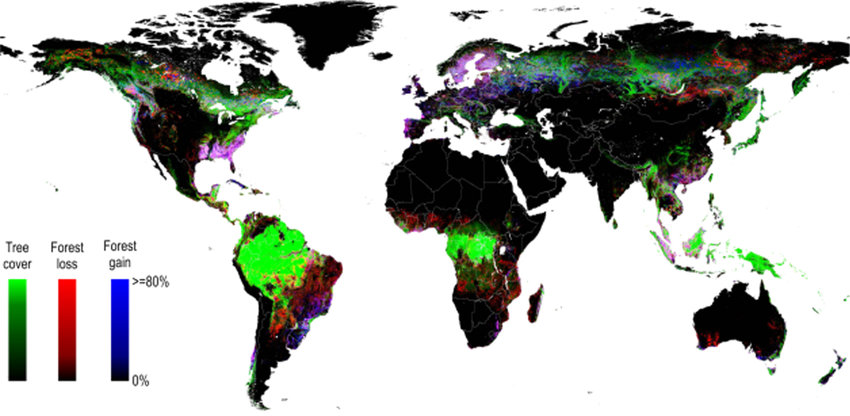The wide availability of forest and land cover maps based on satellite data provides more information on the world’s forests than ever before. However, this plethora of information can also be challenging for people trying to understand differences in data sources and decide which data to use for a specific purpose.
In the past, we’ve compared the annual tree cover loss data from the University of Maryland (UMD) and available on Global Forest Watch (GFW) with national data from Brazil and Indonesia, as well as with data from the United Nations Food and Agriculture Organization’s (FAO) Global Forest Resources Assessment, to shed light on some of these differences.
Another data set that tracks forest change in the tropics is the Tropical Moist Forest (TMF) data set from the European Commission Joint Research Centre (JRC). Like the UMD tree cover loss data, the JRC TMF data is based on Landsat satellite imagery and is updated annually. Yet while both data sets map forest disturbances, the maps and numbers look a little different.
In this blog, we explain some key differences in the definitions and methods used for each data set that impact the resulting maps and discuss how the disturbances mapped by both data sets compare (while the data sets also map forest gain or regrowth, this blog focuses on comparing their mapping of forest disturbances). While understanding these differences can help determine the contexts for which each data set might be useful, note that this analysis does not evaluate the quality or accuracy of either data set.
What areas do the JRC and UMD data sets cover, and how do they define forests?
The UMD data set maps forests globally based on tree cover extent in 2000. Tree cover is defined as woody vegetation with a minimum height of at least five meters at 30-meter resolution, which includes all types of tree cover — including natural or managed forest and plantations — and is not limited to a specific forest type. The GFW map shows tree cover with a 30% canopy density, which we use in our analyses and in this comparison, although users can adjust the threshold based on their needs.
The JRC data set, on the other hand, maps forests beginning in 1990. The data includes all closed primary and secondary forests in the humid tropics and does not apply a minimum height or canopy density threshold to delineate forest extent.
As a result of these definitional differences, some areas included in the 2000 UMD tree cover extent in the tropics like dry forests, young secondary forests and plantations are not classified as forests in the JRC data set in 2000 — a total of 655 million hectares (Mha), or 34%, of the UMD tree cover extent area that overlaps with the JRC data. Likewise, the JRC forest extent in 2000 includes some areas that do not meet the height and 30% canopy density threshold in the UMD data or are otherwise not mapped as tree cover by the UMD data — 17.2 Mha, or 1% of the JRC forest extent.
Because of the differences in geographic coverage and scope between the two data sets, this blog only compares forest disturbances from 2001-2022 for areas that, in the year 2000, are mapped both as tree cover by UMD and as forest by JRC.
What types of forest disturbances do the UMD and JRC data map?
The JRC Tropical Moist Forest data set maps degradation and deforestation in the humid tropics
The JRC TMF data set maps disturbances to tropical moist forests — including degradation and deforestation — from 1990 to 2022. The JRC team maps these changes using an algorithm that detects forest disruptions, meaning an absence of tree foliage cover within a 30-meter pixel for each available Landsat image, and then classifies the status of forest based on how long these disruptions are visible.
The TMF data set defines degradation as temporary disturbances occurring for up to 2.5 years, while it defines deforestation as longer-term disturbances where disruptions to tree cover are visible for more than 2.5 years and no tree regrowth is detected over the last three years. In any given year, a forest is considered disturbed if there is a disruption detected in at least one Landsat image during that year.
Thus, pixels classified as degraded are still considered forest, with existing or regrowing trees, while pixels classified as deforested are undergoing a longer-term loss of forest. Because disruptions are recorded and analyzed for the entire time series, the data set classifies dynamics over time; for example, a forest pixel may be classified as degraded in one year after a short-term disturbance, then after a period of recovery may later be classified as deforested after ongoing disturbances with no tree regrowth. The JRC deforestation class therefore includes direct deforestation (deforestation of undisturbed forest) or deforestation after degradation (deforestation of forest that was previously classified as degraded).
The data set also analyzes the frequency, duration of disruptions and time of forest recovery in between disruption events to identify deforestation following degradation versus multiple degradation events.
The UMD tree cover loss data set on GFW maps all types of tree cover loss globally
The UMD tree cover loss data set maps annual tree cover loss from 2001 to 2022. The UMD team uses an algorithm that detects loss using change detection metrics based on comparison of Landsat images between the present and past years. Tree cover loss, defined as a clearing of tree cover of at least a half of a 30-meter Landsat pixel, includes both temporary and permanent losses without defining or differentiating which loss is considered degradation or deforestation. Once classified as loss, pixels are masked from further updates, meaning that any following forest change dynamics — such as regrowth or subsequent disturbances — are not recorded.
The UMD tree cover loss data can be combined with contextual data layers, such as UMD’s map of humid tropical primary forest, to see loss within specific forest types.
KEY DIFFERENCES BETWEEN THE JRC TMF AND UMD TREE COVER LOSS DATA
| JRC TMF | UMD tree cover loss | |
| Temporal coverage | 1990-2022 | 2000-2022 |
| Geographic coverage and extent | Tropical moist forest: closed primary and secondary forests in the humid tropics in 1990. | Global tree cover: woody vegetation with a minimum height of at least five meters at 30-meter resolution in 2000. |
| Definition of disturbance | An absence of tree foliage cover within a 30-meter pixel. | Clearing of at least half of tree cover within a 30-meter pixel. |
| Disturbance classes | Disturbances are classified as degradation if they are visible for less than 2.5 years, and deforestation if they are visible for more than 2.5 years with no vegetative regrowth over the last three years. | All disturbances classified as tree cover loss. The length of disturbance is not considered. |
| Methods | Classifies valid single-date Landsat images and derives disturbance classes by analyzing the single-date classifications. Dynamics of disturbance events over time are recorded. | Classifies change using change detection metrics derived from all valid Landsat images over the present and past years. Only the first loss event that is detected is recorded. |
What do the UMD and JRC data show about forest disturbances in the tropics?
Overall, the JRC data detects a larger area of disturbances across the tropics from 2001-2022 compared with the UMD data. The JRC data detects 258 Mha of disturbances, including 113 Mha of degradation and 145 Mha of deforestation, while the UMD data detects 143 Mha of tree cover loss. However, trends in total deforestation mapped by JRC and tree cover loss mapped by UMD are generally aligned: They are largely similar for the first decade; then from 2013-2015, JRC detects a larger area as deforestation than UMD detects as loss, and after 2016, UMD detects a larger area.




